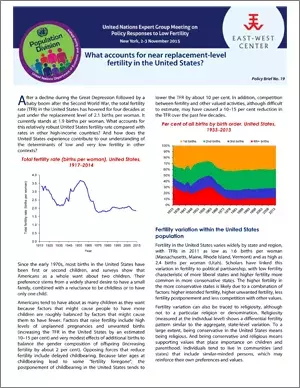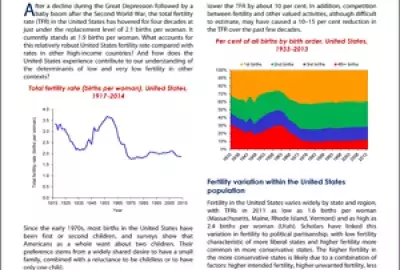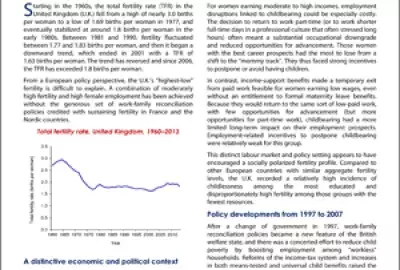Error message

After a decline during the Great Depression followed by a baby boom after the Second World War, the total fertility rate (TFR) in the United States has hovered for four decades at just under the replacement level of 2.1 births per woman. It currently stands at 1.9 births per woman. What accounts for this relatively robust United States fertility rate compared with rates in other high-income countries? And how does the United States experience contribute to our understanding of the determinants of low and very low fertility in other contexts? Since the early 1970s, most births in the United States have been first or second children, and surveys show that Americans as a whole want about two children. Their preference stems from a widely shared desire to have a small family, combined with a reluctance to be childless or to have only one child. Americans tend to have about as many children as they want because factors that might cause people to have more children are roughly balanced by factors that might cause them to have fewer. Factors that raise fertility include high levels of unplanned pregnancies and unwanted births (increasing the TFR in the United States by an estimated 10-15 per cent) and very modest effects of additional births to balance the gender composition of offspring (increasing fertility by about 2 per cent). Opposing forces that reduce fertility include delayed childbearing. Because later ages at childbearing lead to some "fertility foregone", the postponement of childbearing in the United States tends to lower the TFR by about 10 per cent. In addition, competition between fertility and other valued activities, although difficult to estimate, may have caused a 10-15 per cent reduction in the TFR over the past few decades.
|
After a decline during the Great Depression followed by a baby boom after the Second World War, the total fertility rate (TFR) in the United States has hovered for four decades at just under the replacement level of 2.1 births per woman. It currently stands at 1.9 births per woman. What accounts for this relatively robust United States fertility rate compared with rates in other high-income countries? And how does the United States experience contribute to our understanding of the determinants of low and very low fertility in other contexts? Since the early 1970s, most births in the United States have been first or second children, and surveys show that Americans as a whole want about two children. Their preference stems from a widely shared desire to have a small family, combined with a reluctance to be childless or to have only one child. Americans tend to have about as many children as they want because factors that might cause people to have more children are roughly balanced by factors that might cause them to have fewer. Factors that raise fertility include high levels of unplanned pregnancies and unwanted births (increasing the TFR in the United States by an estimated 10-15 per cent) and very modest effects of additional births to balance the gender composition of offspring (increasing fertility by about 2 per cent). Opposing forces that reduce fertility include delayed childbearing. Because later ages at childbearing lead to some "fertility foregone", the postponement of childbearing in the United States tends to lower the TFR by about 10 per cent. In addition, competition between fertility and other valued activities, although difficult to estimate, may have caused a 10-15 per cent reduction in the TFR over the past few decades.
|
Policy Briefs - United Nations Expert Group Meeting on Policy Responses to Low Fertility







